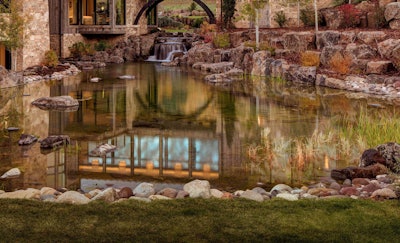 Natural swimming pools are in the minority in the United States, but some are starting to see the appeal.
Natural swimming pools are in the minority in the United States, but some are starting to see the appeal.Photo: BioNova Natural Pools
People love cooling off in a pool in the heat of summer. But linger too long and the chlorine can take a toll on skin and hair. Now imagine a swimming pool that does not use chlorine or chemicals and you’ve got a natural swimming pool.
So what exactly is a natural swimming pool and what makes it different from traditional pools?
Natural swimming pools (NSPs) are kept clean by an ecosystem of plants and beneficial bacteria. Introduced in the early 1980s in Austria, they gradually became popular across Europe. Eventually, interest in NSPs spread to America, although the pools have attracted attention here slowly.
Curiosity about them is understandable. How could plants possibly keep a swimming area clean enough?
According to BioNova Natural Pools, the water in an NSP is moved through a biological filter. Thanks to the beneficial plant life and bacteria’s feeding on undesirable elements in the regeneration zone, the water is cleaned.
The regeneration zone is similar to a water garden. In addition to cleaning the water, it creates a natural oasis atmosphere. The size of the regeneration zone should be equal to the swimming zone.
The plants that are used vary depending on location. Three types of aquatic plants are used: floating, emergent and submerged. Their roots are placed in gravel or other kinds of aggregates. Specific examples of these plants include cattails, pickerel weed, water lilies, lotus and iris.
 NSPs can pull off the traditional look of a normal swimming pool without the chlorine.
NSPs can pull off the traditional look of a normal swimming pool without the chlorine.Photo: BioNova Natural Pools
Clients have the option of choosing whether the regeneration zone is connected to the swimming zone or isolated in a separate pool. An energy-efficient pump is used to keep the water flowing through the biological filter.
The pools can be designed to look as wild as a natural pond or as conservative as a traditional pool.
Only a handful of U.S. landscaping companies currently offer NSPs as one of their services. Most of these companies are partnered with the biggest names in the NSP business, BioTop and BioNova, both of which have roots in Europe.
BioNova Natural Pools was the first NSP system provider in North America and has recently finished the first public NSP in the United States at Webber Park in Minneapolis, Minnesota.
Introduced in 2008, BioNova is headquartered in New Jersey and has experienced exponential client and installation growth. Even so, its NSP installations represent only a fraction of 1 percent of America’s pools.
“The biggest obstacle is perception,” says Alan Weene, head of marketing and technical support for BioNova. “Just like anything else that is green or environmentally stable, Americans are notoriously slow to accept the change.”
Misconceptions are a major issue for the natural swimming pool industry. Some fallacies: that building a NSP by oneself is easier than using a professional or that natural swimming pools are cheaper.
“Long-term operational costs are lower,” Weene says. “There are significantly less energy costs. Initial installation of natural swimming pools is more expensive.”
 Photo: BioNova Natural Pools
Photo: BioNova Natural PoolsOther misconceptions are that natural pools require no maintenance or that they only work in colder climates.
“If you want to maintain water quality, the maintenance is no more or less than a traditional pool,” Weene says. “It’s just different. Rather than adding chemicals, you’re going to be spending time in the water garden – trimming, pruning and removing organic debris – otherwise they will cause a chemical imbalance.”
NSPs are not climate specific, according to Weene, who says BioNova pools have been installed successfully in 45 countries.
“The whole purpose of a natural swimming pool is recreating what is found in nature by combining fresh-water science and modern-day pool construction,” he said. “We don’t add bacteria; they come naturally. The plants perform nutrient absorption, which helps stop algae from forming.”
Total Habitat, a company that primarily focuses on zoo exhibit design, has a different method for creating something similar to NSPs. Total Habitat uses a biological filtration system that is also able to work in any type of climate.
Because it uses UV sterilizers, Total Habitat’s pools do not fit the internationally accepted definition of a NSP.
Mick Hilleary, president of Total Habitat, says the regeneration zones are actually not very effective at cleaning the water.
“The Europeans have a cute thing, but not a lot of science,” he said. “I’ve been to Austria and seen their pools. If the temperature gets above (77 degrees Fahrenheit), then they start pumping in very cold water. What we do works in southern Florida.”
 Total Habitat’s chemical-free pools use biological filters, rather than regeneration zones.
Total Habitat’s chemical-free pools use biological filters, rather than regeneration zones.Photo: Total Habitat
Hilleary’s company has developed a formula to calculate how much perforated pipe is needed to draw the pool water into the biological filter. Their filter medium of choice is expanded shale, due to the fact that it is inert and does not change the water quality.
“Limestone gravel would be horrible, because you’d end up with a quarry pool,” Hilleary said.
The expanded shale absorbs phosphorous, which is string algae’s food source. If flattened out, the shale is actually acres of living space that houses beneficial bacteria.
The filter can be buried in the walls or floors of the pool or even in a separate pool, though this is not commonly done. Bottom jets are used to stir up the water and oxygenate it.
Hilleary built his first chemical-free pool in 2001 and says that client’s pump is still running.
While BioNova and Total Habitat may not agree on each other’s methods, they do agree that the market for chemical-free pools is small at the moment. Most of BioNova’s clients have either grown up accustomed to swimming in ponds or have a desire for a chemical-free lifestyle.
Hilleary admitted that this departure from tradition swimming pools is not for everybody.
“But the people that do have them say they would never go back to the traditional ones,” he said.
Both companies offer conversions from traditional pools to their systems, but this is far more expensive.
“It’s a trickier operation,” Hilleary said. “It’s like converting your car to a bus. Why not build a bus?”










